engine CHEVROLET COLORADO 2004 1.G Workshop Manual
[x] Cancel search | Manufacturer: CHEVROLET, Model Year: 2004, Model line: COLORADO, Model: CHEVROLET COLORADO 2004 1.GPages: 414, PDF Size: 2.71 MB
Page 246 of 414

If You Do Decide To Pull A Trailer
If you do, here are some important points:
There are many different laws, including speed limit
restrictions, having to do with trailering. Make sure
your rig will be legal, not only where you live
but also where you’ll be driving. A good source for
this information can be state or provincial police.
Consider using a sway control. You can ask a hitch
dealer about sway controls.
Don’t tow a trailer at all during the �rst
500 miles (800 km) your new vehicle is driven.
Your engine, axle or other parts could be damaged.
Then, during the �rst 500 miles (800 km) that
you tow a trailer, don’t drive over 50 mph (80 km/h)
and don’t make starts at full throttle. This helps
your engine and other parts of your vehicle wear in
at the heavier loads.
You may want to shift the transmission to THIRD (3)
or, if necessary, a lower gear selection if the
transmission shifts too often (e.g., under heavy
loads and/or hilly conditions). If you have a manual
transmission and you are towing a trailer, it’s
better not to use the highest gear.Three important considerations have to do with weight:
the weight of the trailer,
the weight of the trailer tongue
and the weight on your vehicle’s tires.
Weight of the Trailer
How heavy can a trailer safely be?
It depends on how you plan to use your rig. For
example, speed, altitude, road grades, outside
temperature and how much your vehicle is used to pull
a trailer are all important. And, it can also depend
on any special equipment that you have on your vehicle.
The following chart shows how much your trailer can
weigh, based upon your vehicle model and options.
Maximum trailer weight is calculated assuming only the
driver is in the tow vehicle and it has all the required
trailering equipment. The weight of additional optional
equipment, passengers and cargo in the tow vehicle
must be subtracted from the maximum trailer weight.
The weight of the trailer tongue also affects trailering
capacity. See “Weight of the Trailer Tongue” next.
4-58
Page 247 of 414

Vehicle Axle Ratio Maximum Trailer Weight GCWR**
2WD Regular Cab
Automatic Transmission,
2.8 L Engine3.73 3,500 lbs. (1 587 kg) 7,000 lbs. (3 175 kg)
Automatic Transmission,
3.5 L Engine3.42 4,000 lbs. (1 814 kg) 8,500 lbs. (3 856 kg)
Automatic Transmission,
3.5 L Engine3.73 4,000 lbs. (1 814 kg) 8,500 lbs. (3 855 kg)
Manual Transmission,
2.8 L Engine3.42 2,000 lbs. (907 kg) 5,500 lbs. (2 495 kg)
Manual Transmission,
2.8 L Engine3.73 2,500 lbs. (1 133 kg) 6,000 lbs. (2 722 kg)
Manual Transmission,
3.5 L Engine3.42 3,500 lbs. (1 587 kg) 7,000 lbs. (3 175 kg)
Manual Transmission,
3.5 L Engine3.73 3,900 lbs. (1 769 kg) 7,500 lbs. (3 402 kg)
Vehicle Axle Ratio Maximum Trailer Weight GCWR**
2WD Extended Cab
Automatic Transmission,
2.8 L Engine3.73 3,200 lbs. (1 451 kg) 7,000 lbs. (3 175 kg)
Automatic Transmission,
3.5 L Engine3.42 4,000 lbs. (1 814 kg) 8,500 lbs. (3 856 kg)
Automatic Transmission,
3.5 L Engine3.73 4,000 lbs. (1 814 kg) 9,000 lbs. (4 082 kg)
4-59
Page 248 of 414
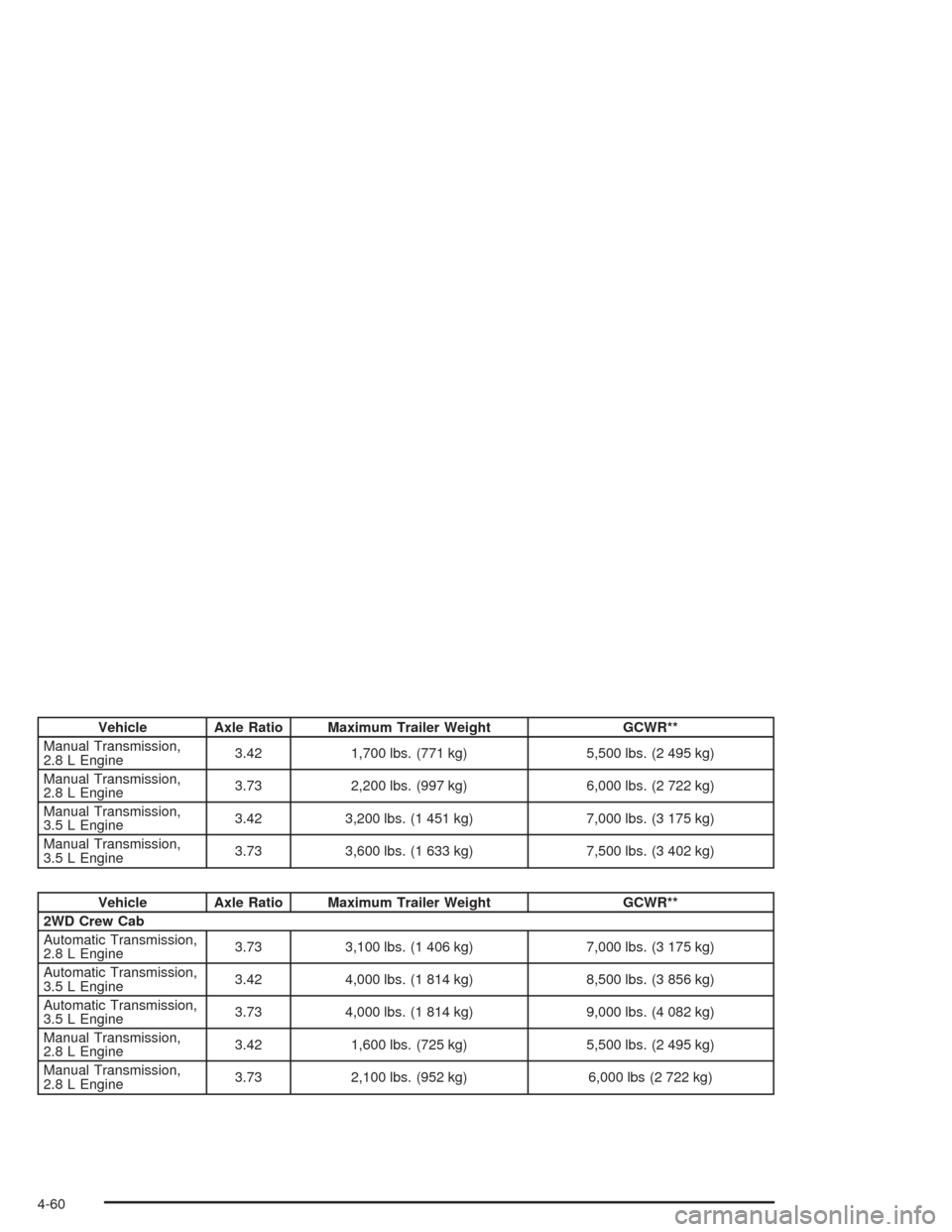
Vehicle Axle Ratio Maximum Trailer Weight GCWR**
Manual Transmission,
2.8 L Engine3.42 1,700 lbs. (771 kg) 5,500 lbs. (2 495 kg)
Manual Transmission,
2.8 L Engine3.73 2,200 lbs. (997 kg) 6,000 lbs. (2 722 kg)
Manual Transmission,
3.5 L Engine3.42 3,200 lbs. (1 451 kg) 7,000 lbs. (3 175 kg)
Manual Transmission,
3.5 L Engine3.73 3,600 lbs. (1 633 kg) 7,500 lbs. (3 402 kg)
Vehicle Axle Ratio Maximum Trailer Weight GCWR**
2WD Crew Cab
Automatic Transmission,
2.8 L Engine3.73 3,100 lbs. (1 406 kg) 7,000 lbs. (3 175 kg)
Automatic Transmission,
3.5 L Engine3.42 4,000 lbs. (1 814 kg) 8,500 lbs. (3 856 kg)
Automatic Transmission,
3.5 L Engine3.73 4,000 lbs. (1 814 kg) 9,000 lbs. (4 082 kg)
Manual Transmission,
2.8 L Engine3.42 1,600 lbs. (725 kg) 5,500 lbs. (2 495 kg)
Manual Transmission,
2.8 L Engine3.73 2,100 lbs. (952 kg) 6,000 lbs (2 722 kg)
4-60
Page 249 of 414
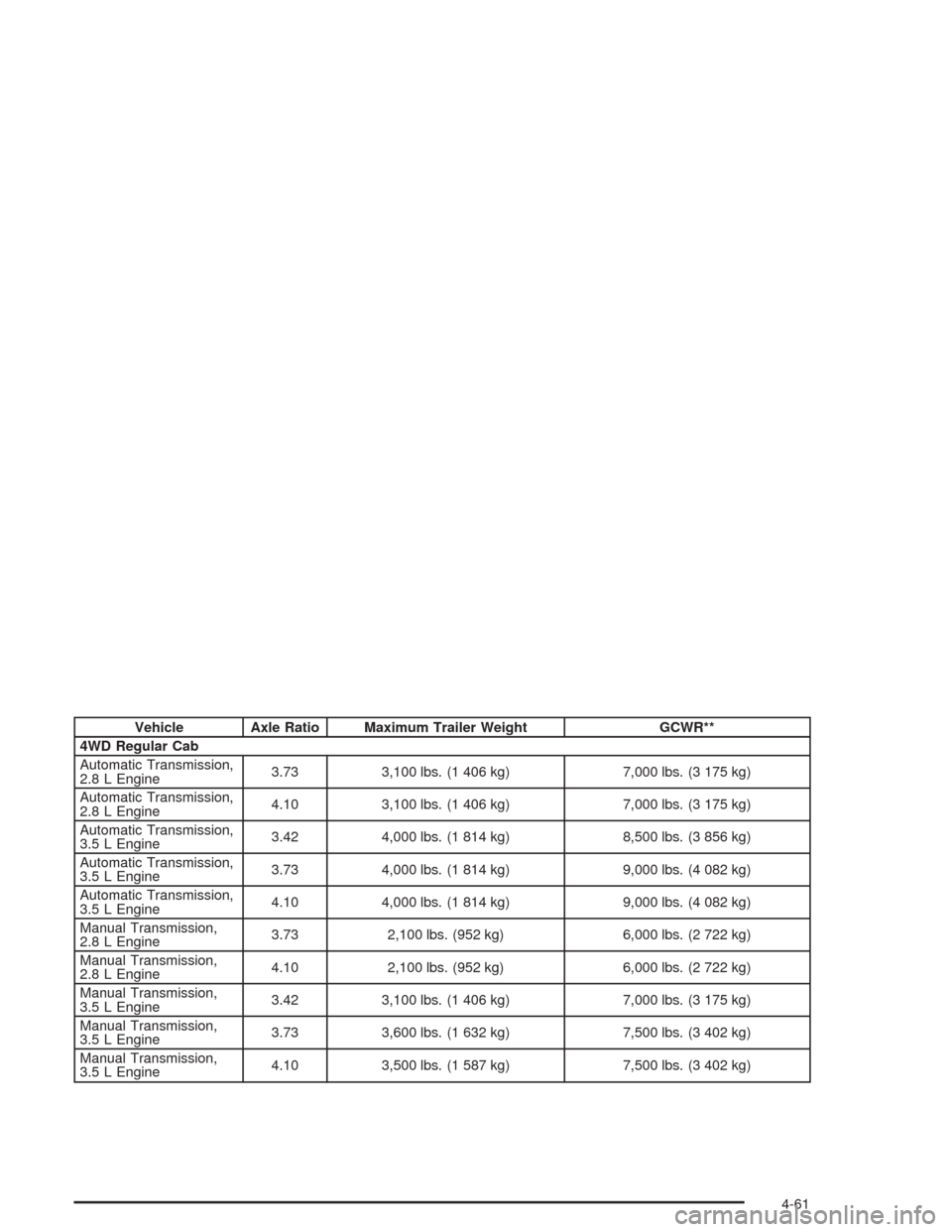
Vehicle Axle Ratio Maximum Trailer Weight GCWR**
4WD Regular Cab
Automatic Transmission,
2.8 L Engine3.73 3,100 lbs. (1 406 kg) 7,000 lbs. (3 175 kg)
Automatic Transmission,
2.8 L Engine4.10 3,100 lbs. (1 406 kg) 7,000 lbs. (3 175 kg)
Automatic Transmission,
3.5 L Engine3.42 4,000 lbs. (1 814 kg) 8,500 lbs. (3 856 kg)
Automatic Transmission,
3.5 L Engine3.73 4,000 lbs. (1 814 kg) 9,000 lbs. (4 082 kg)
Automatic Transmission,
3.5 L Engine4.10 4,000 lbs. (1 814 kg) 9,000 lbs. (4 082 kg)
Manual Transmission,
2.8 L Engine3.73 2,100 lbs. (952 kg) 6,000 lbs. (2 722 kg)
Manual Transmission,
2.8 L Engine4.10 2,100 lbs. (952 kg) 6,000 lbs. (2 722 kg)
Manual Transmission,
3.5 L Engine3.42 3,100 lbs. (1 406 kg) 7,000 lbs. (3 175 kg)
Manual Transmission,
3.5 L Engine3.73 3,600 lbs. (1 632 kg) 7,500 lbs. (3 402 kg)
Manual Transmission,
3.5 L Engine4.10 3,500 lbs. (1 587 kg) 7,500 lbs. (3 402 kg)
4-61
Page 250 of 414
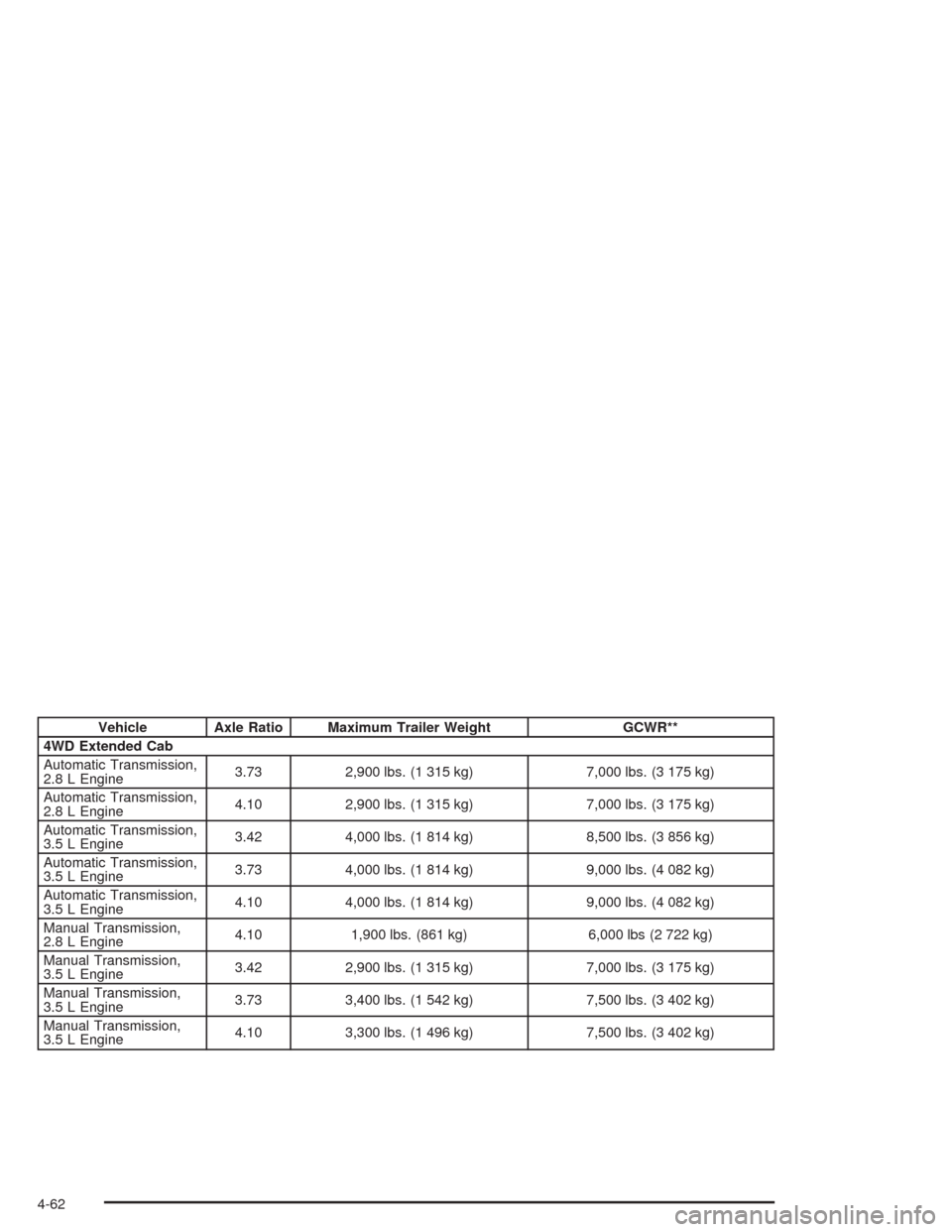
Vehicle Axle Ratio Maximum Trailer Weight GCWR**
4WD Extended Cab
Automatic Transmission,
2.8 L Engine3.73 2,900 lbs. (1 315 kg) 7,000 lbs. (3 175 kg)
Automatic Transmission,
2.8 L Engine4.10 2,900 lbs. (1 315 kg) 7,000 lbs. (3 175 kg)
Automatic Transmission,
3.5 L Engine3.42 4,000 lbs. (1 814 kg) 8,500 lbs. (3 856 kg)
Automatic Transmission,
3.5 L Engine3.73 4,000 lbs. (1 814 kg) 9,000 lbs. (4 082 kg)
Automatic Transmission,
3.5 L Engine4.10 4,000 lbs. (1 814 kg) 9,000 lbs. (4 082 kg)
Manual Transmission,
2.8 L Engine4.10 1,900 lbs. (861 kg) 6,000 lbs (2 722 kg)
Manual Transmission,
3.5 L Engine3.42 2,900 lbs. (1 315 kg) 7,000 lbs. (3 175 kg)
Manual Transmission,
3.5 L Engine3.73 3,400 lbs. (1 542 kg) 7,500 lbs. (3 402 kg)
Manual Transmission,
3.5 L Engine4.10 3,300 lbs. (1 496 kg) 7,500 lbs. (3 402 kg)
4-62
Page 251 of 414
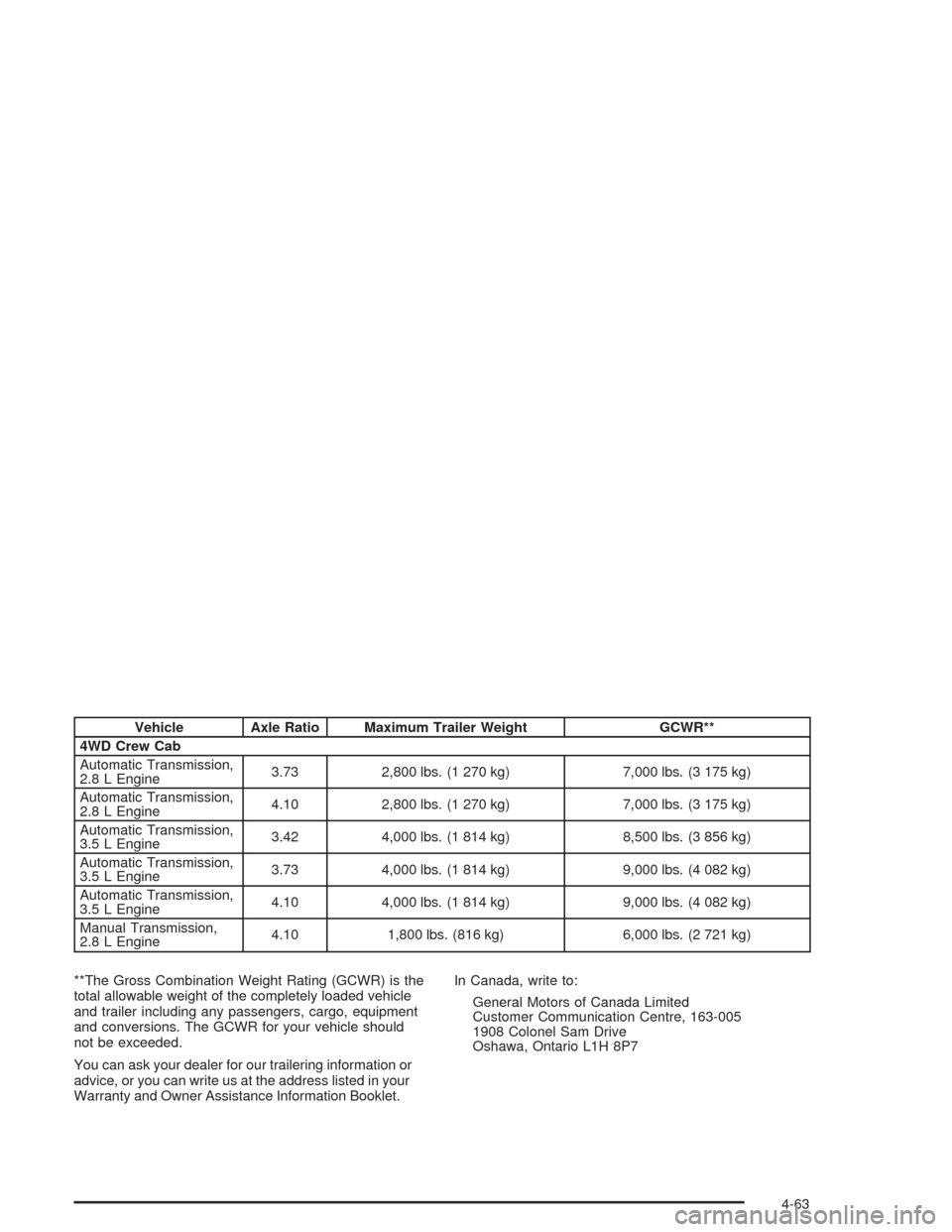
Vehicle Axle Ratio Maximum Trailer Weight GCWR**
4WD Crew Cab
Automatic Transmission,
2.8 L Engine3.73 2,800 lbs. (1 270 kg) 7,000 lbs. (3 175 kg)
Automatic Transmission,
2.8 L Engine4.10 2,800 lbs. (1 270 kg) 7,000 lbs. (3 175 kg)
Automatic Transmission,
3.5 L Engine3.42 4,000 lbs. (1 814 kg) 8,500 lbs. (3 856 kg)
Automatic Transmission,
3.5 L Engine3.73 4,000 lbs. (1 814 kg) 9,000 lbs. (4 082 kg)
Automatic Transmission,
3.5 L Engine4.10 4,000 lbs. (1 814 kg) 9,000 lbs. (4 082 kg)
Manual Transmission,
2.8 L Engine4.10 1,800 lbs. (816 kg) 6,000 lbs. (2 721 kg)
**The Gross Combination Weight Rating (GCWR) is the
total allowable weight of the completely loaded vehicle
and trailer including any passengers, cargo, equipment
and conversions. The GCWR for your vehicle should
not be exceeded.
You can ask your dealer for our trailering information or
advice, or you can write us at the address listed in your
Warranty and Owner Assistance Information Booklet.In Canada, write to:
General Motors of Canada Limited
Customer Communication Centre, 163-005
1908 Colonel Sam Drive
Oshawa, Ontario L1H 8P7
4-63
Page 255 of 414

Backing Up
Hold the bottom of the steering wheel with one hand.
Then, to move the trailer to the left, just move that hand
to the left. To move the trailer to the right, move your
hand to the right. Always back up slowly and, if possible,
have someone guide you.
Making Turns
Notice:Making very sharp turns while trailering
could cause the trailer to come in contact with the
vehicle. Your vehicle could be damaged. Avoid
making very sharp turns while trailering.
When you’re turning with a trailer, make wider turns than
normal. Do this so your trailer won’t strike soft shoulders,
curbs, road signs, trees or other objects. Avoid jerky or
sudden maneuvers. Signal well in advance.
Turn Signals When Towing a Trailer
When you tow a trailer, your vehicle has to have extra
wiring and a heavy-duty turn signal �asher.
The arrows on your instrument panel will �ash whenever
you signal a turn or lane change. Properly hooked up,
the trailer lamps will also �ash, telling other drivers
you’re about to turn, change lanes or stop.When towing a trailer, the arrows on your instrument
panel will �ash for turns even if the bulbs on the trailer
are burned out. Thus, you may think drivers behind
you are seeing your signal when they are not. It’s
important to check occasionally to be sure the trailer
bulbs are still working.
Driving On Grades
Reduce speed and shift to a lower gear before you start
down a long or steep downgrade. If you don’t shift
down, you might have to use your brakes so much that
they would get hot and no longer work well.
When towing at high altitude on steep uphill grades,
consider the following: Engine coolant will boil at a lower
temperature than at normal altitudes. If you turn your
engine off immediately after towing at high altitude
on steep uphill grades, your vehicle may show signs
similar to engine overheating. To avoid this, let the
engine run while parked (preferably on level ground)
with the automatic transmission in PARK (P) (or
the manual transmission out of gear and the parking
brake applied) for a few minutes before turning the
engine off. If you do get the overheat warning,
seeEngine Overheating on page 5-28.
4-67
Page 257 of 414
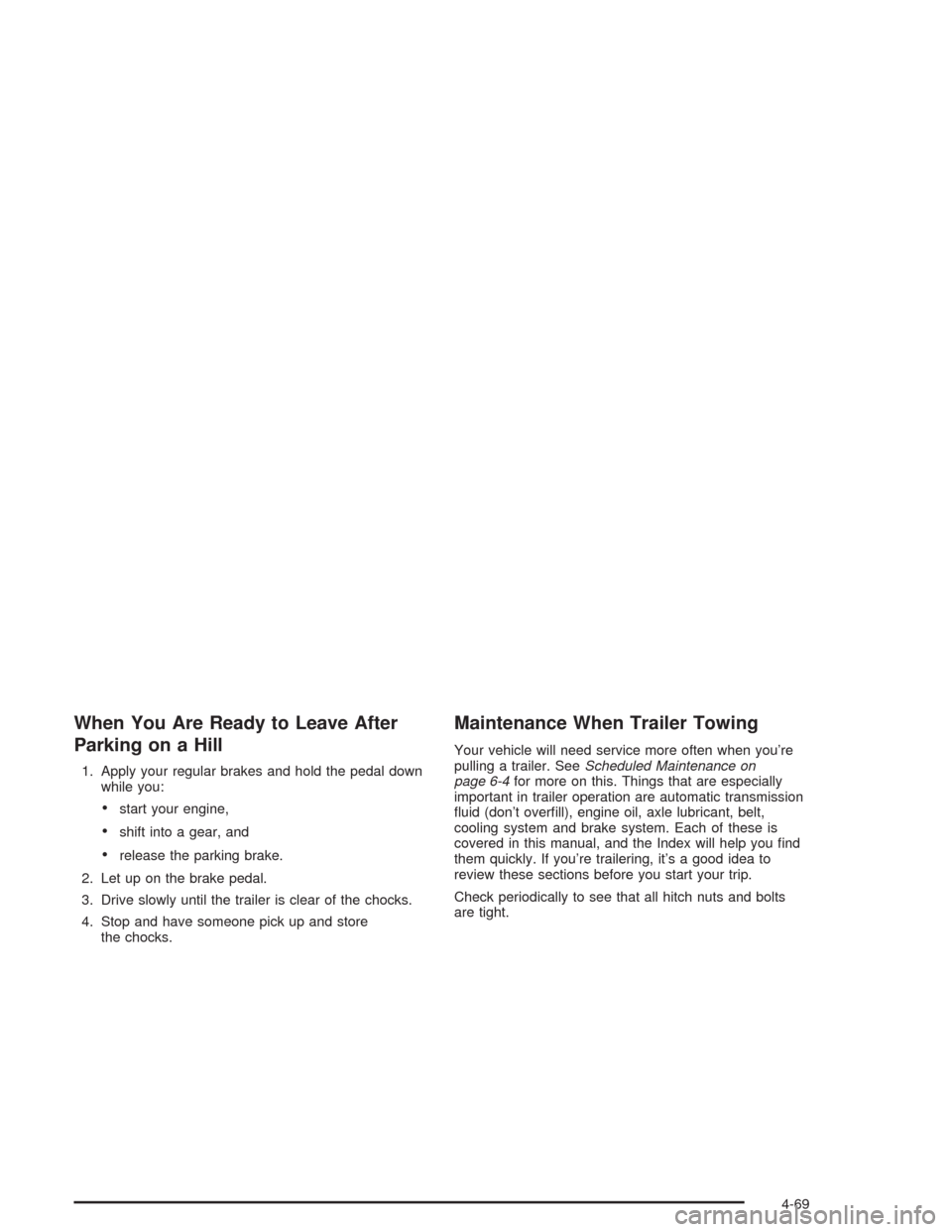
When You Are Ready to Leave After
Parking on a Hill
1. Apply your regular brakes and hold the pedal down
while you:
start your engine,
shift into a gear, and
release the parking brake.
2. Let up on the brake pedal.
3. Drive slowly until the trailer is clear of the chocks.
4. Stop and have someone pick up and store
the chocks.
Maintenance When Trailer Towing
Your vehicle will need service more often when you’re
pulling a trailer. SeeScheduled Maintenance on
page 6-4for more on this. Things that are especially
important in trailer operation are automatic transmission
�uid (don’t over�ll), engine oil, axle lubricant, belt,
cooling system and brake system. Each of these is
covered in this manual, and the Index will help you �nd
them quickly. If you’re trailering, it’s a good idea to
review these sections before you start your trip.
Check periodically to see that all hitch nuts and bolts
are tight.
4-69
Page 259 of 414

Service............................................................5-3
Doing Your Own Service Work.........................5-4
Adding Equipment to the Outside of
Your Vehicle..............................................5-4
Fuel................................................................5-5
Gasoline Octane............................................5-5
Gasoline Speci�cations....................................5-5
California Fuel...............................................5-6
Additives.......................................................5-6
Fuels in Foreign Countries...............................5-7
Filling Your Tank............................................5-7
Filling a Portable Fuel Container.....................5-10
Checking Things Under the Hood....................5-10
Hood Release..............................................5-11
Engine Compartment Overview.......................5-12
Engine Oil...................................................5-13
Engine Air Cleaner/Filter................................5-18
Automatic Transmission Fluid.........................5-19
Manual Transmission Fluid.............................5-22
Hydraulic Clutch (Manual Transmission)...........5-24
Engine Coolant.............................................5-25
Radiator Pressure Cap..................................5-28Engine Overheating.......................................5-28
Cooling System............................................5-30
Engine Fan Noise.........................................5-36
Power Steering Fluid.....................................5-36
Windshield Washer Fluid................................5-37
Brakes........................................................5-39
Battery........................................................5-42
Jump Starting...............................................5-43
Rear Axle.......................................................5-48
Four-Wheel Drive............................................5-48
Front Axle......................................................5-49
Bulb Replacement..........................................5-50
Halogen Bulbs..............................................5-50
Headlamps..................................................5-50
Front Turn Signal, Sidemarker and Daytime
Running Lamps.........................................5-52
Center High-Mounted Stoplamp (CHMSL).........5-53
Taillamps, Turn Signal, Stoplamps and
Back-up Lamps.........................................5-53
Replacement Bulbs.......................................5-54
Windshield Wiper Blade Replacement..............5-55
Section 5 Service and Appearance Care
5-1
Page 261 of 414

Service
Your dealer knows your vehicle best and wants you to
be happy with it. We hope you will go to your dealer
for all your service needs. You will get genuine GM parts
and GM-trained and supported service people.
We hope you will want to keep your GM vehicle all GM.
Genuine GM parts have one of these marks:
California Proposition 65 Warning
Most motor vehicles, including this one, contain and/or
emit chemicals known to the State of California to
cause cancer and birth defects or other reproductive
harm. Engine exhaust, many parts and systems
(including some inside the vehicle), many �uids, and
some component wear by-products contain and/or emit
these chemicals.
5-3